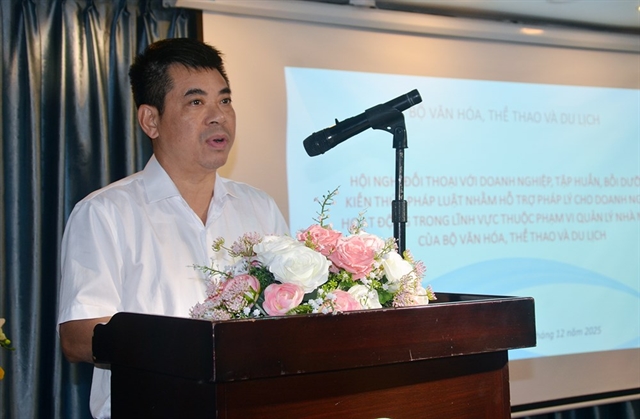 Life & Style
Life & Style

 |
| Lacquer paintings are on display in Hà Vĩ Communal House at 11 Hàng Hòm Street, Hà Nội. Photo hanoi.gov.vn |
HÀ NỘI — Artists and artisans around Hà Nội have brought their lacquer works together in a display dedicated to Trần Lư, the founder of the craft in Việt Nam.
Entitled Sắc Son (The Tone of Cinnabar), the exhibition also aims to promote creative expression in a space rich in artistic value — the Hà Vĩ Communal House on the capital city's Hàng Hòm Street.
Documentary evidence shows that during the reign of Lê Thánh Tông (1443 - 1460), Trần Lư, a native of Bình Vọng Village in Hà Nội's Thường Tín District, was the first person to create the lacquerware profession and was honoured as its founder.
He twice went to Hunan Province in China to improve his skill in making lacquer and to learn the techniques of gold and silver inlay to disseminate to the villagers. Later, Lư came to Thăng Long citadel to make a living producing lacquered wooden goods.
Through the centuries, the traditional lacquer craft endured and still exists today, contributing to Việt Nam's cultural identity.
"It is an effort to popularise Hà Vĩ Communal House, which is long associated with the history of lacquer craft," said Nguyễn Mạnh Linh, chairman of the People's Committee in Hàng Gai Ward.
The exhibition is inspired by the cinnabar hue found in traditional Vietnamese lacquer. Cinnabar and black are considered the two primary colours in traditional lacquer, alongside materials like gold and silver leaf, mother-of-pearl and eggshell.
The works on display range widely in form and expression, from traditional lacquer paintings and lacquer-covered wooden statues by contemporary painters to handicraft products created by lacquer artisans.
Artists involved in the exhibition include Vũ Xuân Đồng, Trương Hoàng Hải, Lại Minh Huyên, Bùi Kim Hiền, Đinh Văn Trọng, Ngô Thanh Bắc, Trần Công Dũng, Lolo Zazar and Trần Văn Giáp, among others. Each presents a unique interpretation of lacquer art, showcasing a rich palette of materials, techniques and personal styles.
In addition to traditional lacquer works showcasing the familiar red vermilion by artists like Hiền and Huyên, the exhibition also includes experimental pieces.
These include Zazar's combinations of traditional vermilion with industrial materials or innovative media like the experimental lacquer photography done by exhibit curator Nguyễn Thế Sơn.
A light installation by Đông interacts with traditional 'lantern clouds' and the golden hues of Hà Vĩ Communal House's intricate attic architecture.
"The red of cinnabar is traditionally classified into four shades, each used in various ways to build a diverse and expressive colour palette in Vietnamese lacquer painting," said Sơn.
"More than just a colour, cinnabar becomes a soulful tone, embodying the unique spirit of Vietnamese lacquer art."
Complementing the main works are exhibits that turn the space into a miniature lacquer craft museum.
Two lacquer trees have been planted in the courtyard by Bắc, along with a display of tools and materials used in the lacquer making process — from sap-collecting instruments to specialised tools for painting and crafting — from Hải.
These additions help viewers visualise the entire process of lacquer crafting, from raw material to finished product, while also showcasing its diverse applications in everyday life — all guided by the evocative tone of cinnabar, which connects to the traditional cultural identity of Việt Nam.
Sắc Son, a celebration of craftsmanship, culture and the enduring spirit of creativity, is open to the public at 11 Hàng Hòm Street until August 16. — VNS




